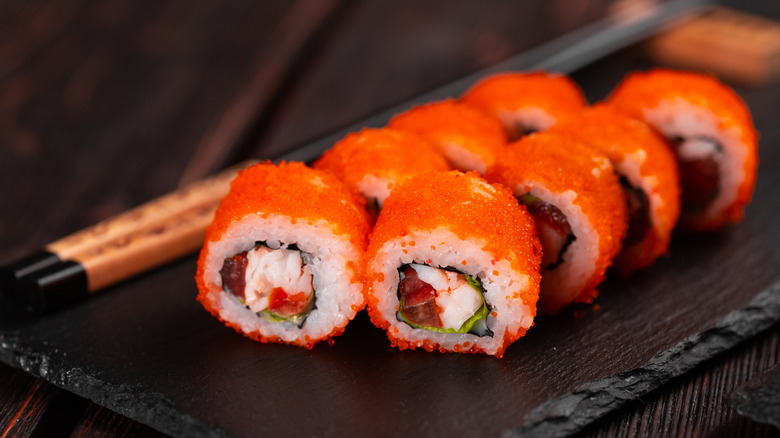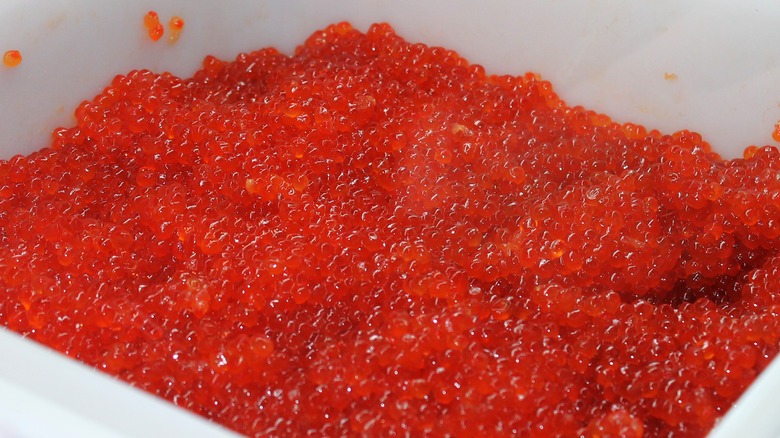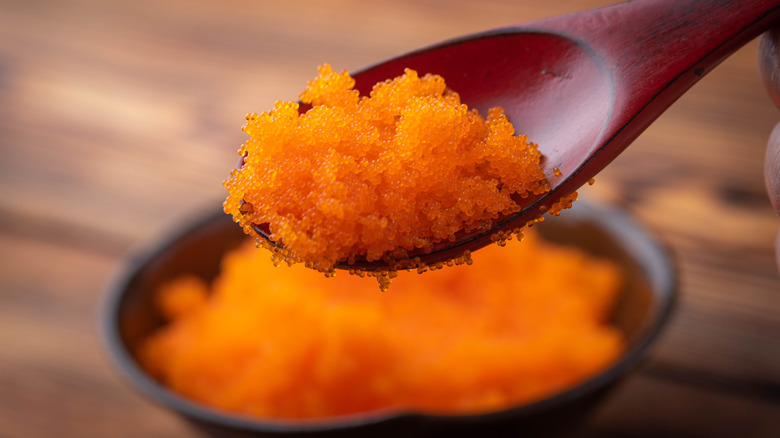Tobiko Vs. Masago: The Major Difference Between These Fish Eggs
Despite only being introduced to the United States around 1970, sushi has ascended to become one of the most popular foods in the country. That means you've probably encountered tobiko and masago on more than one occasion. However, it's very possible that neither of those terms is familiar to you because both tobiko and masago are often referred to plainly as fish roe or fish eggs. They are not to be confused with caviar, a different (and far more expensive) type of fish roe — but they provide a similarly unique mouthfeel, like itsy bitsy balloons that pop between your teeth.
Fish roe is a frequent addition to many types of sushi rolls, as well as some iterations of sashimi, nigiri, and donburi. And while Japanese cuisine incorporates roe from many different species of fish, the two that you've most likely seen on sushi are tobiko and masago. It is easy to mistake one for the other, as they are both quite small and share similar orange hues. However, they come from very different species of fish and have subtle distinctions in taste, texture, nutritional value, and price that you should be aware of.
What is tobiko?
Tobiko refers to the eggs of flying fish, famous for leaping from ocean to air to evade predators. Of course, that doesn't stop us humans from getting our hands on their prized eggs. Although tobiko can come from multiple species of flying fish, the Japanese flying fish (Cheilopogon agoo) is particularly common, and the likely origin of any tobiko you get with your sushi.
These eggs are tiny, not more than a millimeter in diameter, and with a firm exterior, they really pop on your tongue. Tobiko is often cured in salt before serving, and a sense of ocean brininess dominates the flavor profile. However, the saltiness is given further depth by the presence of a subtle smokey note — if you are familiar with the taste of other fish eggs, such as caviar, you'll find that tobiko tastes just a bit sweeter.
Tobiko naturally has a dark orange hue, but sushi chefs often dye it with extracts from other food sources. Aside from its natural orange state, tobiko can come in red, black, green, and yellow varieties. Red tobiko is the most common version, and it is dyed with beet juice. Black tobiko may take the cake as the most eye-catching version, appearing like microscopic orbs of onyx thanks to the addition of squid ink. Green and yellow tobiko are especially notable for their unique flavors. Green tobiko is dyed with wasabi, lending a touch of spice, while the addition of yuzu gives yellow tobiko a tart, citrusy taste.
What is masago?
Masago refers to the roe from various species of smelt, which may differ depending on where you get your sushi. In Japan, masago typically comes from shishamo fish (Spirinchus lanceolatus), which are abundant in the waters off Hokkaido in the northern portion of the country. In the U.S. on the other hand, masago most often comes from the capelin, a sardine-esque fish found in the world's northernmost oceans. Capelin are an extremely plentiful and accessible species, so while tobiko and masago are both pretty inexpensive, the latter tends to be the cheapest.
Additionally, masago has a subtly different appearance from tobiko with its natural color being more of a pale yellow. However, much like tobiko, masago is frequently dyed with other ingredients — typically going for a brighter orange shade — making this a hard distinction to spot. They also differ in size, with masago being even smaller than tobiko, almost like fine sand.
Because masago eggs are so minuscule, you don't feel the same distinct pop between your teeth that you get from tobiko. Instead, masago has a softer, smoother texture with only a hint of crispness. Taste-wise, masago is salt-forward, but this is rounded out by a gentle citrusy flavor. It is also slightly bitter compared to tobiko.
When it comes to your sushi order in the U.S., you're most likely to receive masago because it's more common as restaurants favor its affordability.


